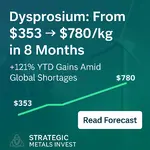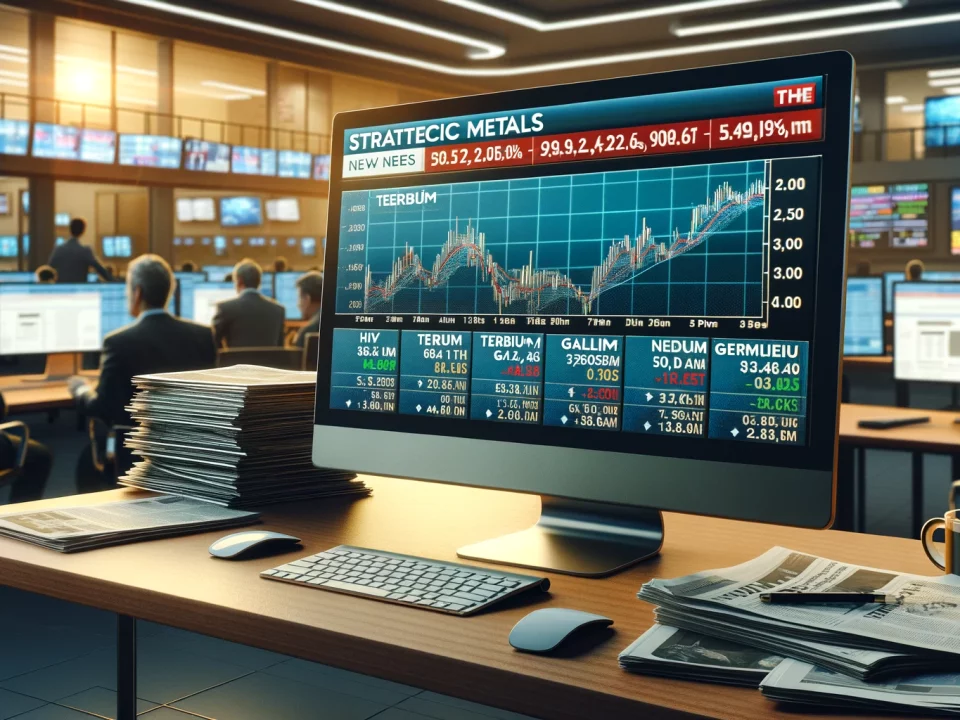
Dysprosium Sep 2025 Price Update: From $353 to $780/kg in 8 Months
September 4, 2025
Weekly News Review September 8 – September 14 2025
September 14, 2025This week, significant moves in the critical minerals sector highlighted both recycling and expansion efforts worldwide. India launched a significant program to recycle critical raw materials from e-waste and used batteries, aiming to recover 40 kilotons annually and create up to 70,000 jobs. Meanwhile, Korean company JS Link announced plans to build a rare earth magnet facility in Georgia, and Aclara secured U.S. funding for its Brazilian rare earth project.
All this and more from the newsroom.
US DOD FUNDS GALLIUM RECOVERY FROM WASTE STREAMS:
Australia-based Metallium has announced that its U.S. subsidiary, Flash Metals Texas, has secured a Phase I Small Business Innovation Research (SBIR) contract from the U.S. Department of Defense to demonstrate its proprietary technology for recovering gallium from recycled electronic waste and industrial scrap.
The award, valued at $65,000, will fund a six-month proof-of-concept program using Metallium’s Flash Joule Heating (FJH) process. This method applies ultra-rapid electrical discharges to heat materials to around 3,000°C in milliseconds, enabling the efficient separation and recovery of gallium and potentially other valuable elements. The technology was developed in collaboration with a team of researchers from Rice University in Houston, Texas, which has pioneered this method, aiming to reduce the costs and greenhouse gas emissions associated with traditional recycling methods such as hydrometallurgy and pyrometallurgy (we reported).
If the initial phase is successful, the company will be eligible to apply for Phase II funding of up to $1 million to scale pilot operations, followed by Phase III commercialization contracts ranging from $10 to $100 million.
Gallium has become one of the most critical elements for the United States. Since mid-2023, exports from China, which supplies the majority of the world’s gallium, have been subject to a licensing system that prohibits shipments abroad without official licenses. In December 2024, China further escalated its restrictions by halting all shipments to the U.S. indefinitely, highlighting its dependency.
ACLARA SECURES US BACKING FOR BRAZILIAN RARE EARTH PROJECT:
The Carina heavy rare earths project is one of two ventures the mining company is developing in South America.
Canada-based Aclara Resources has secured up to $5 million in funding from the U.S. International Development Finance Corporation (DFC) to advance its Carina heavy rare earths project in Goiás, Brazil. The investment will finance a feasibility study that is already in progress, with an expected completion date of early 2026. It builds on top of a pre-feasibility study, which is scheduled to be released later this month. The Carina Project is targeted to begin operations in 2028.
In addition to the project in Brazil, Aclara is advancing another ion-adsorption clay project in Chile, tapping into resources that, until now, have only been mined in China and Myanmar on a large scale. The company is also building a rare earth separation facility in the United States, aiming to vertically integrate processing from mine to magnet. The plan is to produce carbonate in South America and refine it into individual rare earth elements in North America. The company is also advancing a joint venture with Chilean steelmaker CAP S.A. to produce rare earth metals and alloys.
To complete the value chain, Aclara signed a strategic partnership last year with German magnet manufacturer Vacuumschmelze, which is building a magnet production facility in South Carolina. A potential supply agreement could establish a mine-to-magnet value chain from South to North America.
EUROPE: WIND ENERGY EXPANSION TOO SLOW –
WindEurope warns that EU climate targets will not be met and calls for faster approvals.
The expansion of wind energy in Europe is progressing too slowly, according to the industry association WindEurope, based on an evaluation of the latest data. At 6.8 gigawatts (GW) in the first half of the year, 5.3 of which were in the EU, the increase is below forecasts. According to WindEurope, this jeopardizes the EU’s energy supply and climate targets for 2030, as well as the region’s economic competitiveness.
“Cheaper electricity is essential to remain competitive with China and the United States,” said CEO Giles Dickson.
He warned that a slowdown in wind power expansion also threatens growth and jobs in industries such as steel, chemicals, and information and communications technology.
Europe now has a total wind energy capacity of 291 GW. The association expects this figure to reach 344 GW by 2030, but the EU’s target is 425 GW. According to the findings, only a few countries are promoting these renewable energy sources sufficiently.
Germany is an exception, as it was the first country to implement the new EU approval regulations. Approvals are usually granted within 18 months, while in the rest of the bloc, it takes 24 months or longer. With 2.2 GW, the majority of new capacity in the first half of 2025 also came from Germany, followed by Spain with 889 megawatts and the United Kingdom with 760 megawatts.
In addition to the lengthy approval procedures, WindEurope cites the slow expansion of the power grids and “suboptimal auction design” as weaknesses, among other things. In the past, the association has repeatedly called for secure access to the necessary raw materials. One crucial group of elements is rare earths, which are used in many wind turbines.
In the turbines, rare earth magnets help convert rotational motion into electrical current. China has a near monopoly on these materials. In view of these challenges, WindEurope is calling for closer cooperation between European governments. To drive forward the expansion of wind power, it is now necessary to implement EU approval regulations, but also to modernize electricity grids and strengthen local supply chains.
UNITED STATES: JS LINK (KOREA) TO BUILD RARE EARTH MAGNET FACILITY IN GEORGIA –
U.S. subsidiary to construct a 3,000-ton-per-year plant, which would rank among the largest in the country.
JS Link America Inc., the U.S. subsidiary of Korean company JS Link, will invest approximately $223 million to establish a rare earth permanent magnet manufacturing plant in Columbus, Georgia, Governor Brian P. Kemp announced.
The facility is expected to have an annual production capacity of approximately 3,000 tons, with operations slated to begin in late 2027. If completed as planned, the Columbus plant would rank among the largest permanent magnet production sites outside of China. However, JS Link has not yet disclosed its source of feedstock.
Earlier this year, the company signed a partnership with Australian rare earth producer Lynas to build a comparable 3,000-ton-per-year facility in Malaysia, suggesting potential supply chain synergies (we reported). For its other plant in Yesan, Korea, which is nearing completion, Lynas is also the raw materials supplier, according to JS Link’s monthly newsletter.
Currently, the U.S. hosts only a handful of small-scale rare earth magnet plants, while China dominates the sector, producing more than 90% of global supply. In recent years, however, momentum has been building to diversify production. In addition to JS Link, U.S.-based MP Materials, the country’s largest rare earth miner, and Australia’s Lynas, the biggest company in the sector outside China, are both developing new facilities in the United States. German manufacturer Vacuumschmelze is also nearing completion of its new facility in South Carolina.
INDIA STEPS UP TO RECYCLE CRITICAL RAW MATERIALS ANNUALLY:
Cabinet approves state incentives to boost recycling industry.
India is stepping up efforts to recover critical raw materials from electronic waste and used batteries. On Wednesday, the Cabinet approved measures to provide state support for companies in this sector, the Ministry of Mines announced. Firms can now receive government grants for constructing recycling facilities, purchasing necessary machinery, and covering operational costs.
The government has allocated approximately $170 million, with one-third of the funds reserved explicitly for startups.
Under the program, which runs through spring 2031, New Delhi expects to recover around 40 kilotons of critical raw materials annually while creating up to 70,000 direct and indirect jobs. Investments exceeding $900 million are also anticipated.
As Asia’s third-largest economy, India relies heavily on imports of certain raw materials and specialized industrial components, many of which come from China, such as rare earth magnets. To strengthen domestic manufacturing, India is seeking international partnerships to enhance its capabilities. The country has also announced plans to develop a domestic ecosystem for recycling high-performance magnets, further reducing its dependency on imports.
RUSSIA: PUTIN ORDERS FAST TRACK PLAN FOR DOMESTIC RARE EARTH INDUSTRY –
Plan for the domestic rare earth sector development to be approved by November.
According to estimates from the U.S. Geological Survey (USGS), Russia holds nearly four million tons of rare earth reserves. However, despite this vast potential, the country produced only 2,500 tons last year, a figure that placed it behind India.
President Vladimir Putin has now instructed the government to approve a program for the development of Russia’s rare earth industry by November, as reported by Interfax. He noted that a system for tracking secondary deposits, such as mining tailings, has already been introduced. These often contain valuable resources that could be extracted and utilized, provided the right technologies are in place.
Back in 2020, Russia declared its ambition to overtake China in rare earth production by 2030. However, by November 2024, Putin expressed dissatisfaction with the lack of progress at the country’s most important rare earth deposit, Tomtor in the Far East, citing insufficient investment. A few months later, Rosneft, Russia’s largest oil producer, took control of the project.
Moscow has nonetheless continued to signal its determination to become a major player in the rare earth sector. In March of this year, it even offered the United States cooperation in resource development, a move underscoring the strategic importance Russia attaches to this industry.
Figure of the week – 10% – annual growth is expected in the photovoltaic market, rising from $96.5 billion in 2023 to $155.5 billion by 2028.







1 Comment
Enjoyed looking through this, very good stuff, thankyou.